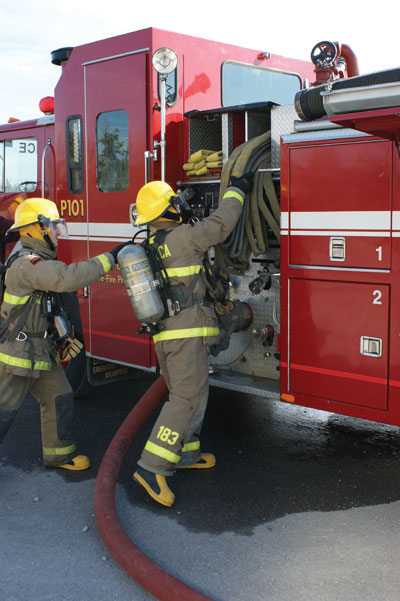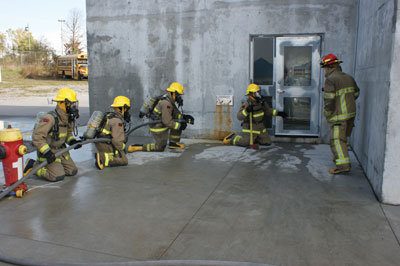
Features
Leadership
Learning how to learn
The delivery of fire-service training and ongoing education hasn’t changed much in more than 20 years.
January 6, 2012
By John Snider
The delivery of fire-service training and ongoing education hasn’t changed much in more than 20 years. Competency-based training has been the standard in Canada’s pre-service programs and in fire departments. But new training strategies that consider the way young adults process information can better prepare trainees and potential recruits so they are ready to enter the fire service, and so that fire chiefs will want to hire them.
 |
|
| Advancing a hoseline into a burning building is a fire-ground task that can be used to demonstrate effective task-centred instruction. Photo by John Snider
|
The NFPA first developed professional qualifications in 1973 and the first edition of NFPA 1001 was published in 1974.
In 1980, this standard was updated to include job performance requirements (JPRs) that recognized the independent skills required to be a firefighter. The easiest and most straightforward instructional methods take the JPRs and translate them into sign-offs based on the trainee’s competency of these skills. Individual skill sign-offs address a limited scope and do not address the need to train well-rounded, critically thinking firefighters who have the ability to multi-task with minimal supervision on the fire ground.
Firefighters need to have the ability to integrate the various JPRs or skills into a task that needs to be performed on the fire ground. Just because a firefighter can fully don SCBA in 60 seconds does not mean he can perform the skill effectively when combining it with a number of other skills on the fire ground.
“The inability to integrate the individual skills into tasks is probably the most frustrating aspect to me,” says Geoff Hoar, a captain with Caledon Fire and Emergency Services in Ontario. “Just because the firefighter demonstrated the ability to do skill X does not translate into the firefighter being able to complete an assigned task.”
Competency-based training is a reasonable approach to developing the individual skills required to be a firefighter, but it is not a progressive instructional method. More effective instructional strategies have been developed that allow the training to better integrate the multitude of skills that need to be combined on the fire ground, and to provide this training using methods and strategies that are well suited to adult learners. As firefighter training progresses, these skills become integrated in future training and/or real emergency calls. Why not start the training with full integration rather than combining these skills later?
The trend in hiring practices seems to be gradually shifting toward pre-service education prior to being hired. This is more aligned with other public emergency services such as paramedicine, policing and nursing. Municipal administrators recognize the potential cost savings involved. Changes in fire-service training have not kept up with this new hiring model, which results in more diversity in the educational and work experience of recruit firefighters.
Jeannette Miller, a professor at Toronto’s Seneca College in the pre-service firefighter program, notes, “There is a definite difference between students that have no hands-on experience and little or no mechanical aptitude, versus candidates that have come from a trades background.”
Gone are the days when all recruits had a trade (auto mechanics, carpentry) when they joined the fire service, and yet the approaches used to train this new, diverse generation of firefighters has not significantly changed.
 |
|
| Fully protected by PPE and a charged hoseline, a pre-service student prepares to safely check the door prior to opening. Photo by John Snider |
Research shows that adults and children learn very differently. Adults can benefit from applying their existing life experiences to achieve their learning goals. Presenting the material in a holistic manner (whole-picture) allows adult learners to visualize the entire task and use their past experiences while developing the skills necessary to complete the task. Learning becomes much more efficient when the adult students can assimilate their past experiences and knowledge with the new firefighting material.
There are a number of other suitable instructional strategies that could be integrated into firefighter training. Task-centred instructional strategy is an approach well suited to adult learning and uses the holistic approach. This instructional strategy can be easily adapted to firefighter training models.
The task-centred instruction strategy starts with an outline of the entire task and then breaks it down into a series of progress micro-tasks, or skills, that build on each other. As each micro-task is introduced, and the learners progress to mastery of that skill, some teaching techniques such as diminished coaching (slowly reducing the amount of instruction) can be introduced for that particular skill. As new micro-tasks are added, the learner has an opportunity to reproduce the previously learned skills as part of a larger picture. This method allows the learner to continually work toward mastering each skill while at the same time gaining an understanding of how that skill fits into the larger task and fire-ground operations. Task-centred learning gives the learner the ability to fully integrate each skill and recognize from the beginning where each piece of the puzzle fits into the overall picture.
Another benefit of this instructional strategy is the development of critically thinking firefighters. Fighting a fire is a dynamic experience and using task-centred learning develops a series of skills that firefighters can pull from their toolbox, depending on the needs of the emergency scene. Competency-based training may give the firefighter all of the individual skills but it does not effectively integrate them into a whole task that may be required at an emergency.
The fire-ground task of advancing a hoseline into a burning building can be used to show how task-centred instruction can be used effectively. Below is a simplified list of skills that a recruit needs to complete for this task:
- donning PPE
- donning SCBA
- size-up
- deploying preconnects
- entry/accountability
- forcible entry
- advancing hoselines
In addition to these hard-task requirements, learners are also required to integrate softer, overlying skills, such as safety considerations (building construction, seatbelts and handling tools), radio use and incident management systems.
Some of these skills are individual skills, some are team-based and most of them are actually completed in a concurrent fashion on the fire ground. Together they form an important progressive task on the fire ground.
In a task-centred approach, learners are given a full demonstration of the task from start to finish. This holistic approach gives the adult learners a clear understanding of where they are headed and, at the same time, shows them the importance of the combination of skills they need to master to get there.
Once demonstrated, the task is broken down into a series of skills, in this example starting with donning of PPE. Once the learners develop a basic competence, they are introduced to the next step (SCBA donning) as a continuation of and integration with donning PPE. Each step in the progression has some knowledge components that can be introduced, along with the practical components to complete the delivery of material.
As skills are developed, the levels of instruction and supervision required for the previous tasks start to diminish as the learners’ abilities improve; academically, this is called a scaffolding approach. This allows instructors to focus on presenting and developing the new skill sets efficiently and in a timely manner while allowing for the repetition of previous skills as part of the process.
“When skills (for example, donning PPE and SCBA) are sequentially integrated into a larger fire-ground tasks, the repeated practice allows the student the opportunity to master these individual skills,” says Hoar.
Once learners develop all of the skills and knowledge required for this task, they have an assortment of tools or skills in their toolbox and the ability to fully integrate them.
The fire service faces two distinct challenges in educating young firefighters: meeting the needs of the young adult learners to provide an efficient and effective learning environment; and updating instructional strategies to better prepare these young firefighters for a career that includes continuing education.
These are not easy challenges to address and it will not be a quick fix, but the fire service needs to recognize the benefits of various learning methods and commit to diversifying the adult education methods used.
It’s time to break the motto “100 years of tradition, unimpeded by progress.” In the new world of fire fighting, with its constant battle of understaffed vehicles and multitasking firefighters, the use of task-based learning is well suited to meet the needs of today’s firefighters.
John Snider has more than 20 years’ experience in the fire service, originally as a volunteer firefighter in Tottenham, Ont., and then as a full-time firefighter for Toronto Fire Services. He has been shift-training instructor for the TFS for 14 years and has been a professor in the pre-service program at Seneca College for 10 years. John has a bachelor of science (Human Kinetics) from the University of Guelph and is finishing a bachelor of education (adult education) at Brock University. He can be reached at john.snider@rogers.com
Print this page